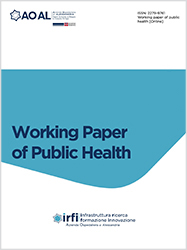Summary of the 2016 World Health Organization Report and 2021 Compendium on environmental diseases

Accepted: 19 January 2023
All claims expressed in this article are solely those of the authors and do not necessarily represent those of their affiliated organizations, or those of the publisher, the editors and the reviewers. Any product that may be evaluated in this article or claim that may be made by its manufacturer is not guaranteed or endorsed by the publisher.
The report written by the World Health Organization (WHO) in 2016 presents an extensive assessment to show how the improvement of the environment can promote health and well-being. The awareness of how many diseases could be avoided by focusing on environmental risk factors would give a boost to global efforts to promote preventive health. The results obtained by the quantitative analysis on the burden of diseases attributable to the environment, confirm that 24% of global deaths and 26% of deaths among children under 5 years are caused by modifiable environmental risk factors. For this reason, this report strongly supports the idea that the environment is a solid platform for good public, community and individual health. Furthermore, in 2021, WHO with the United Nations developed a Compendium, which provides strategies and key guidance for acting on environmental conditions as a key contributor to reducing many communicable and Non-Communicable Diseases (NCDs). In the following article we examined the environment-related diseases according to WHO paperwork.
WHO. Preventing disease through healthy environments: a global assessment of the burden of disease from environmental risks. 2018. Available from: https://www.who.int/publications/i/item/9789241565196
WHO. Compendium of WHO and other UN guidance on health and environment. 2022. Available from: https://www.who.int/tools/compendium-on-health-and-environment
Vector-borne diseases. Key facts. 2020. Available from: https://www.who.int/news-room/fact-sheets/detail/vector-borne-diseases
Bendick C. Sexually Transmitted Infections in the Tropics. Hautarzt. 2018;69:945-959. DOI: https://doi.org/10.1007/s00105-018-4275-6
WHO. Global Hepatitis Report. 2017. Available from: https://www.who.int/publications/i/item/9789241565455
Global Cancer Observatory. 2020. Available from: https://gco.iarc.fr/
World Cancer Research Fund International. 2020. Available from: https://www.wcrf.org/
UNICEF. Danger in the air: how air pollution may be affecting the brain development of young children around the world. 2017. Available from: https://www.unicef.org/sites/default/files/press-releases/glo-media-Danger_in_the_Air.pdf
GBD Results tool. Institute for Health Metrics and Evaluation. 2021 Available from: https://www.healthdata.org/gbd
Copyright (c) 2023 Carlotta Bertolina, Marianna Farotto, Stefania Crivellari, Fabio Giacchero, Chiara Grasso, Marinella Bertolotti, Antonio Maconi

This work is licensed under a Creative Commons Attribution-NonCommercial 4.0 International License.
PAGEPress has chosen to apply the Creative Commons Attribution NonCommercial 4.0 International License (CC BY-NC 4.0) to all manuscripts to be published.

 https://doi.org/10.4081/wpph.2023.9604
https://doi.org/10.4081/wpph.2023.9604




